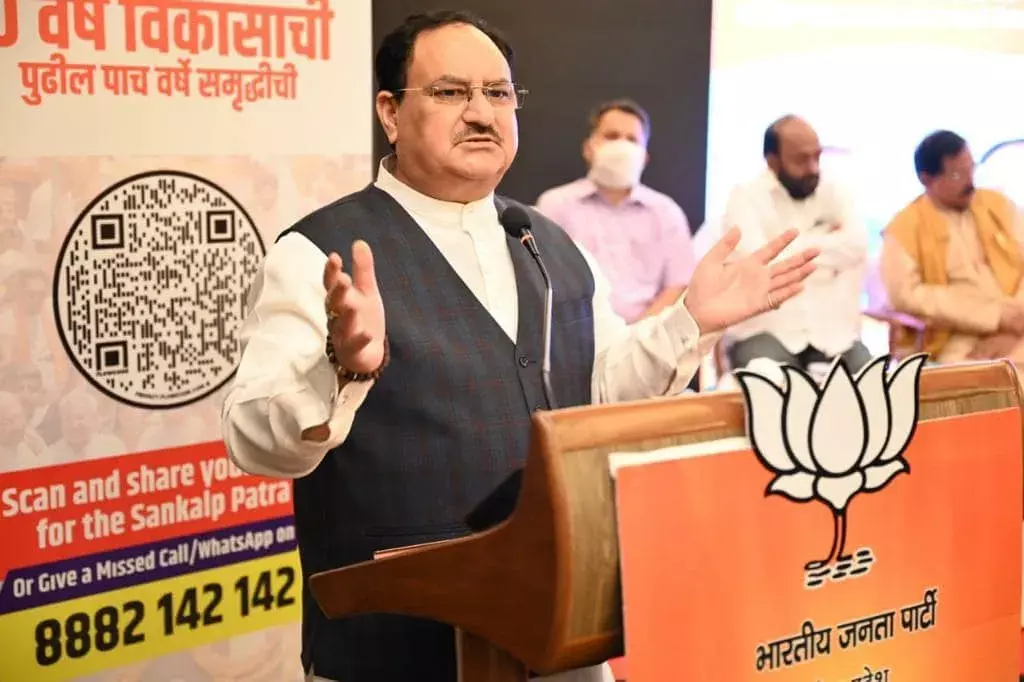Crime in Goa Has Not Reduced by 101% as Nadda Claimed
BJP chief said crime has decreased 101% and, in the press release, he was quoted as saying crime rate has dipped 101%, but neither is true

Credit: Twitter/BJP4Goa
Ahead of the Goa Legislative Assembly Elections, Bharatiya Janata Party National President Jagat Prakash Nadda, on December 22, 2021, released a report card of the party's achievements in the state over the past 10 years. While releasing the card, Nadda made claims regarding the state's crime rate, water supply and primary health centres (PHC).
When verified against official records, FactChecker found one to be false, one misleading and one true.
Claim 1: Crimes has reduced by 101%, said Nadda at the event (in video below at 50.55). But, the press note of the event posted by BJP mentions crime rate instead of crime. "Today the crime rate of Goa has seen a decline of 101%," the release quoted Nadda as saying.
Nadda can be heard making this claim in the video of the event linked below (timestamp- 50:55)
Fact: In neither of the cases, be it crime or crime rate, has the reduction been 101% compared to the statistics in 2011. According to National Crime Records Bureau's records,
6,282 crimes were reported in 2011 and it reduced to 4,366 in 2020. Although the number of crimes has come down in the past decade, but the reduction has been 30.5% and not 101% as Nadda claimed.
Now, in the press note, it was mentioned that crime rate has reduced by 101%. Crime rate is crime per one lakh of population. In 2011, Goa's crime rate was 430.9 which means that there were around 430.9 crimes committed for every one lakh people in Goa. This term is also defined as the rate of cognizable crimes. In 2020, the crime rate dipped to 281.2, which is a 34.74% decrease and not 101% as claimed in BJP's press release.
Claim 2: "The BJP government has also increased the number of PHCs from 19 to 55, thus ensuring proper health coverage across the state," Nadda is quoted as saying in the press release.
Fact: This is true. FactChecker could access rural health statistics dating back to 2005, which showed that number of PHCs then were 19 in rural Goa. The figure remained unchanged till March 2012, when BJP was elected to power in Goa. Currently, there are 55 functioning PHCs in state's rural areas, and four in urban areas, according to a press release issued by Ministry of Health and Family Welfare on December 21, 2021.
The Rural Health Statistics, published by the National Health Mission, show that the number of PHCs in rural Goa started increasing in 2013, when it increased 21. This number rose to 22 in 2016 and 24 in 2017 before it more than doubled to 55 in 2020.
Claim 3: "Under the Jal Jeevan Mission, every household in Goa is being connected with piped water connection. Every household in Goa is being given 16,000 litres of free water every day," claimed Nadda.
A day before the event, on December 21, 2021, BJP tweeted, "Jal Jeevan Mission has ensured 100% drinking water coverage and 16,000 litres of water is being provided daily per family is another major facet of our developmental work."
Fact: This is misleading. According to Jal Jeevan Mission's dashboard, 100% of Goa's households, which are 2.63 lakh, have received piped water connections. But, in a recent analysis, FactChecker found that water supply was irregular in rural areas, with the frequency of supply dropping to once every two days for at most an hour in Goa.
Moreover, the local farmers, villagers, and an official working with the Water Supply & Sanitation scheme of Goa's Public Works Department (PWD) we spoke to said they are troubled by irregular supply.
Then, there are mining-affected villages in the state too that rely solely on tankers for water. Hanumant Parab (45), who lives in Pissurlem village in North Goa with his 11-year-old son, wife, and mother, told FactChecker, "Our village comes under a mining belt, and not all households get tap water despite getting connections. And those who do, get water supply for just three hours daily."
"We used to have a well in the village and were not reliant on tap water earlier. But now, due to mining activities, we only rely on water supplied by tankers, which are provided by the mining companies, and this is also contaminated," he added.
A PWD official FactChecker spoke to stood by the claim that all rural households in Goa have tap water supply, but he also agreed that villages receive irregular supply of water. Santosh Mhapne, Chief Engineer-I at Water Supply & Sanitation scheme of Goa's PWD, said, "In some areas it's for a few hours, but there are areas which receive a 24-hour supply as well. It really depends on the production [in water treatment plants] and supply. There are proposals in the pipeline to augment existing [water treatment] plants, but that will take some time." For FactChecker's more detailed analysis on this, go here.
FactChecker tried contacting Nadda's office but there was no response. We have sent an email and this story will be updated as and when we receive a response.

